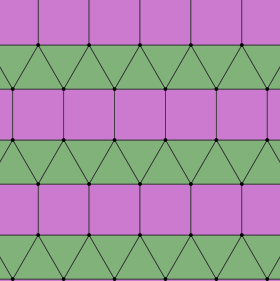| Elongated triangular tiling | |
|---|---|
 | |
| Type | Semiregular tiling |
| Vertex configuration |  3.3.3.4.4 |
| Schläfli symbol | {3,6}:e s{∞}h1{∞} |
| Wythoff symbol | 2 | 2 (2 2) |
| Coxeter diagram | |
| Symmetry | cmm, [∞,2+,∞], (2*22) |
| Rotation symmetry | p2, [∞,2,∞]+, (2222) |
| Bowers acronym | Etrat |
| Dual | Prismatic pentagonal tiling |
| Properties | Vertex-transitive |
In geometry, the elongated triangular tiling is a semiregular tiling of the Euclidean plane. There are three triangles and two squares on each vertex. It is named as a triangular tiling elongated by rows of squares, and given Schläfli symbol {3,6}:e.
Conway calls it a isosnub quadrille.[1]
There are 3 regular and 8 semiregular tilings in the plane. This tiling is similar to the snub square tiling which also has 3 triangles and two squares on a vertex, but in a different order.
- ^ Conway, 2008, p.288 table